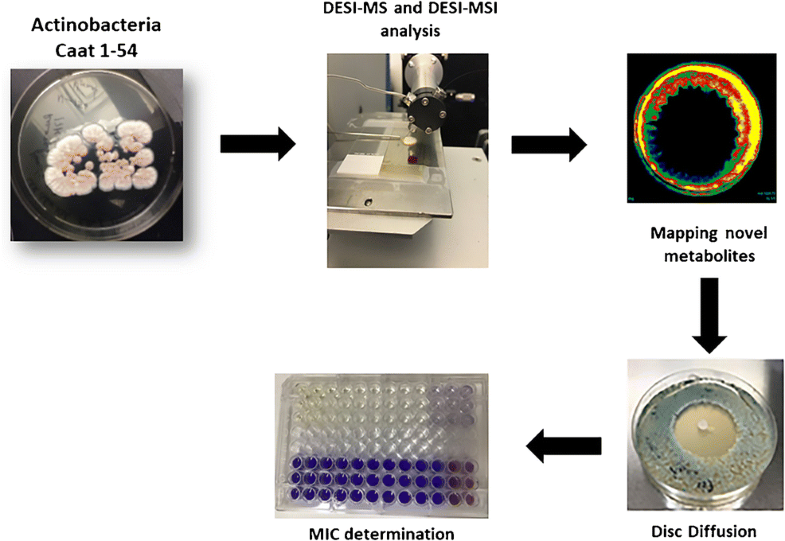Analytical and Bioanalytical Chemistry ( IF 4.3 ) Pub Date : 2018-09-08 , DOI: 10.1007/s00216-018-1315-0 Júlia Pereira Rodrigues , Shamina Saiyara Prova , Luiz Alberto Beraldo Moraes , Demian Rocha Ifa
The discovery of new secondary metabolites is a challenge to biotechnologists due to the emergence of superbugs and drug resistance. Knowledge about biodiversity and the discovery of new microorganisms have become major objectives; thus, new habitats like extreme ecosystems have become places of interest to research. In this context, caatinga is an unexplored biome. The ecosystem caatinga is a rich habitat for thermophilic microbes. Its high temperature and dry climate cause selective microbes to flourish and become established. Actinobacteria (Caat 1-54 genus Streptomyces sp.) isolated from the soil of caatinga was investigated to characterize and map its secondary metabolites by desorption electrospray ionization mass spectrometry imaging (DESI–MSI). With this technique, the production of bioactive metabolites was detected and associated with the different morphological differentiation stages within a typical Streptomyces sp. life cycle. High-resolution mass spectrometry, tandem mass spectrometry, UV–Vis profiling and NMR analysis were also performed to characterize the metabolite ions detected by DESI–MS. A novel compound, which is presumed to be an analogue of the antifungal agent lienomycin, along with the antimicrobial compound lysolipin I were identified in this study to be produced by the bacterium. The potency of these bioactive compounds was further studied by disc diffusion assays and their minimum inhibitory concentrations (MIC) against Bacillus and Penicillium were determined. These bioactive metabolites could be useful to the pharmaceutical industry as candidate compounds, especially given growing concern about increasing resistance to available drugs with the emergence of superbugs. Consequently, the unexplored habitat caatinga affords new possibilities for novel bioactive compound discovery.

ᅟ
中文翻译:

of的次生代谢产物的表征与定位。
由于超级细菌和耐药性的出现,新的次生代谢产物的发现对生物技术人员来说是一个挑战。关于生物多样性的知识和新微生物的发现已成为主要目标;因此,像极端生态系统这样的新栖息地已成为研究的热点。在这种情况下,caatinga是一个尚未开发的生物群落。Caatinga生态系统是嗜热微生物的丰富栖息地。它的高温和干燥气候导致选择性微生物繁衍并建立。放线杆菌(Caat 1-54链霉菌属通过从解吸电喷雾电离质谱成像(DESI–MSI)中研究了从caatinga土中分离出的sp。)来表征和绘制其次生代谢产物的图谱。用这种技术,可以检测出生物活性代谢产物的产生,并与典型的链霉菌内的不同形态分化阶段相关联。sp。生命周期。还进行了高分辨率质谱,串联质谱,UV-Vis分析和NMR分析,以表征由DESI-MS检测到的代谢物离子。在这项研究中,鉴定出了一种新化合物,该化合物被认为是抗真菌药利诺霉素的类似物,同时还与抗微生物化合物lysolipin I一起由细菌产生。通过圆盘扩散试验及其对芽孢杆菌和青霉菌的最低抑菌浓度(MIC),进一步研究了这些生物活性化合物的效力。被确定。这些生物活性代谢物可作为候选化合物对制药业有用,特别是考虑到随着超级细菌的出现,人们对可用药物的抗药性越来越高。因此,未开发的栖息地caatinga为新型生物活性化合物的发现提供了新的可能性。

ᅟ



























 京公网安备 11010802027423号
京公网安备 11010802027423号